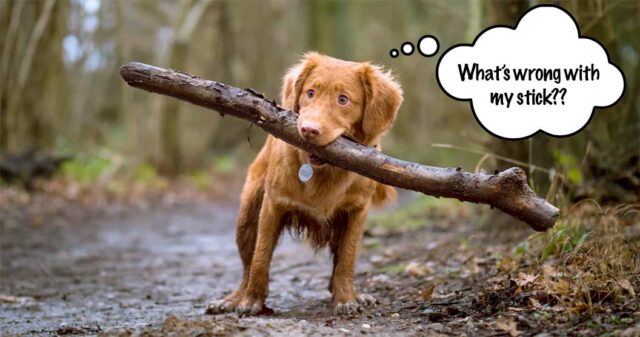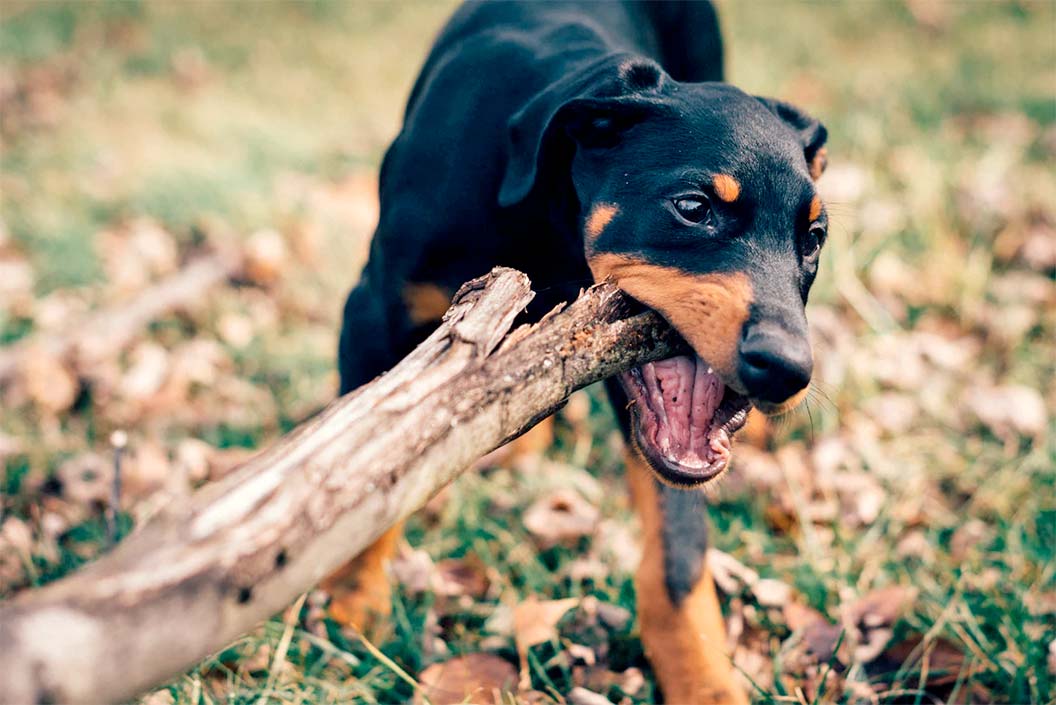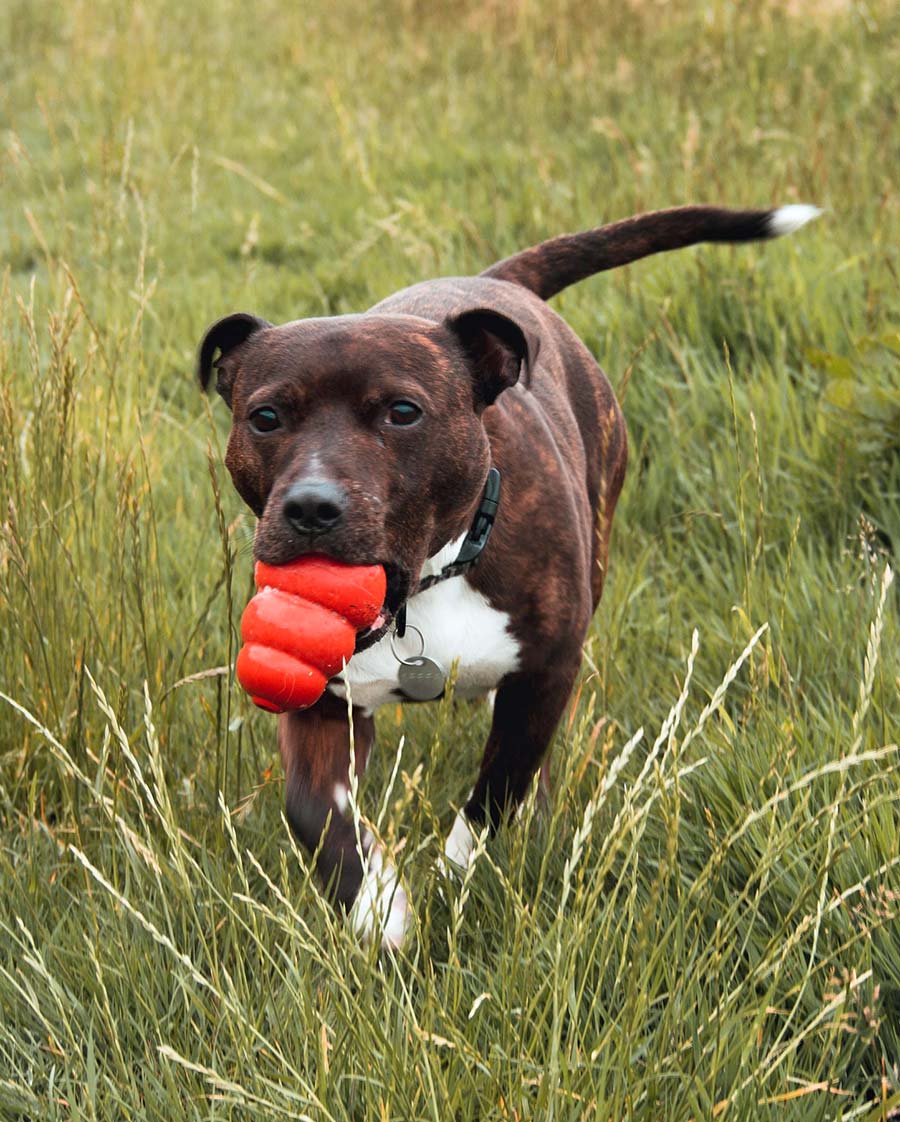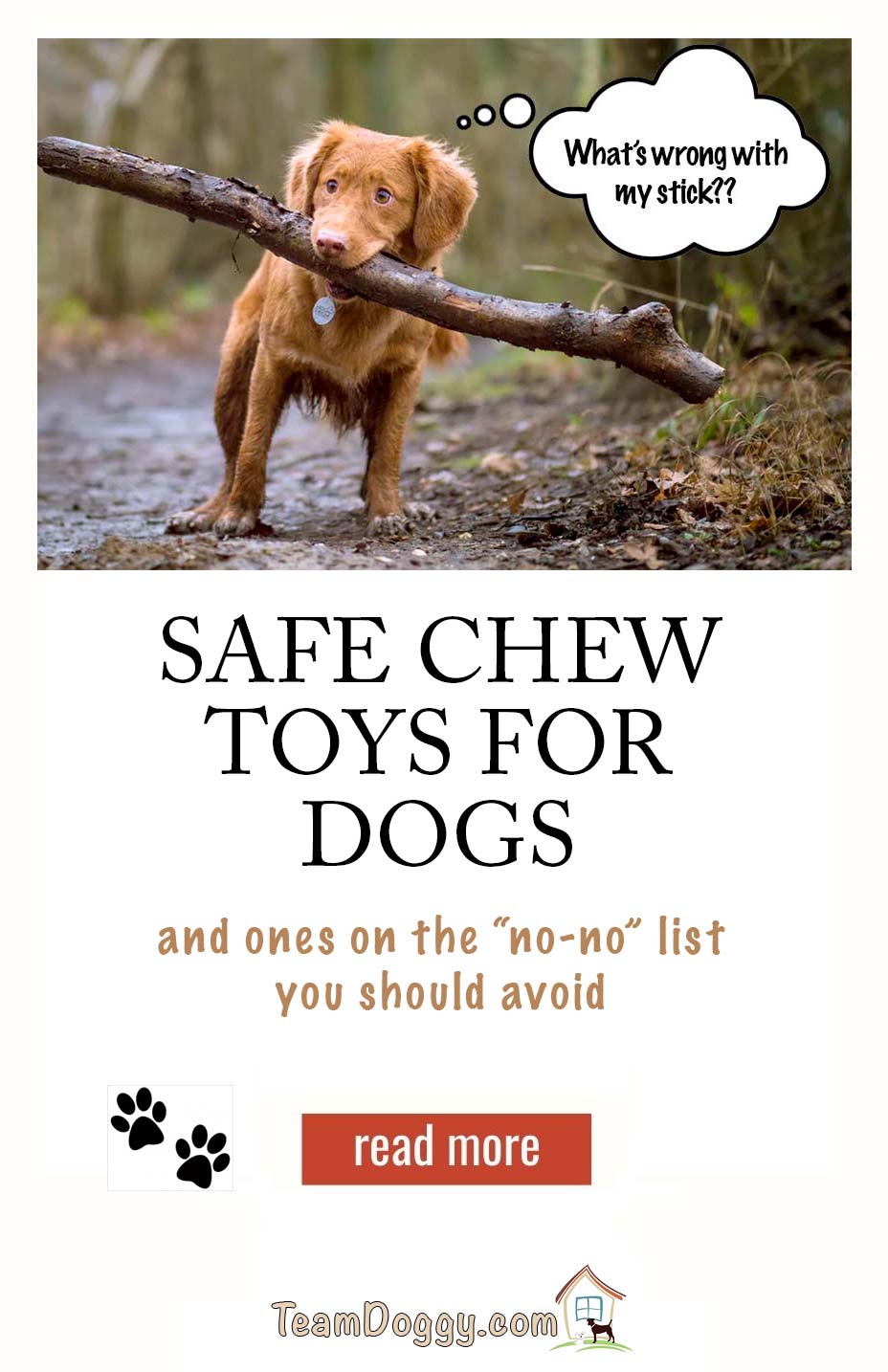
If your dogs are anything like ours your house is littered with fluff and squeaker guts everywhere. It leaves you wondering what are some safe chew toys for dogs?
Plushie toys are pretty much a no-go for us. Even the ones marketed as “tough-as-nails” are torn up in minutes even by little dogs. And everyone knows that dogs love sticks. So why not let them go wild out in the woods?
If you’ve been letting your dog chew on sticks, you might be surprised to learn just how dangerous they can be for your dog’s health. In researching the best chew toys for dogs I ran into numerous veterinary accounts of sticks causing mouth and tongue splinters, punctures to the mouth or throat, choking, eye injuries and even chest, lung and heart impalement. Yikes!
If veterinarians regularly have to treat dogs for stick-related injuries its a good idea to keep your dogs from chewing them. So where does that leave us?
Just because an object looks safe and your dog enjoys it doesn’t mean it’s safe for your dog to chew on. There are many common items dog owners should stop letting their fluffy friends gnaw on.
How do you know what is a safe chew toy and what is dangerous? Here are some pet tips to guide you toward safer chew options, as well as veterinarian recommended safe dog chew toys.
The No-No List of Doggy Chew Toys
There are a lot of things that dog owners let their pets play with that can be dangerous. Each thing poses a different health hazard to your pet. Just because they haven’t gotten injured yet doesn’t mean they’re safe.
Below you’ll find the top offenders in the unsafe chew toys for dogs club. Some of them may surprise you!
Sticks:
It’s hard to take away a fun and free chew toy from your dog, but unfortunately, sticks can pose a serious danger to dogs. The sharp edges of the sticks can cause cuts and punctures in the intestines, leading to infection or even death.
In addition, sticks can become lodged in the throat, making it difficult for the dog to breathe. For these reasons, it is important to be vigilant when your dog is chewing on sticks.
Ice:
While it would seem ice would make a nice cold treat on a hot summer day ice is not safe for dogs to chew on because it can damage their teeth. Many vets will tell you chewing ice can wear down tooth enamel and even lead to broken teeth. Chewing on ice can also lead to choking or intestinal blockages if the piece is big enough.
Rocks:
While rocks may seem like a harmless natural item for dogs to play with, they can actually pose a serious threat to your pet’s health. Rocks can chip or crack your dog’s teeth, and swallowing small pieces can cause digestive problems. In addition, rocks can become lodged in your dog’s throat, causing difficulty breathing.
If your dog happens to swallow a sharp piece of rock, it could puncture their intestines, leading to life-threatening infection. For these reasons, it’s best to avoid letting your dog chew on rocks. There are plenty of other safe and healthy options available that will keep them happy and occupied.
Bones, Antlers & Hooves:
Dog owners have long known that dogs love bones, and they can be a great way to keep their furry friends happy and occupied. But are they really?
Even though dogs have been chewing on bones, antlers, and hooves for ages it doesn’t make them a safe choice. Bones can easily brake and splinter. When the shards are swallowed those sharp fragments can become lodged in the mouth, throat, and intestines. Chicken bones are probably the number one cause of injury but even good solid bones can be problematic.
Antlers, hooves, and dense bones can also be too hard for your dogs teeth. Bones are well known for cracking the crowns off of the big upper 4th premolar teeth. Below we’ll tell you about the hardness test you can perform on your dogs’ chew toys, but essentially antlers, bones, and hooves are simply too hard and can cause chipped and broken teeth.
Nylon Bones:
If natural bones are too hard it must be nylon bones to the rescue, right? Sorry to disappoint but nylon bones are also on the naughty list. When chewed, nylon bones can splinter and break, causing mouth injuries or even puncturing the intestines just like natural bones.
In addition, the synthetic materials used to make nylon bones can be harmful if swallowed, potentially causing gastrointestinal blockages or toxicity.
Water Bottles:
Many dogs would play with a water bottle for hours. Batting it around, crunching and munching it. But water bottles are not safe either. Veterinarians have reported many dogs that have come in with a water bottle cap stuck in their throat.
Additionally, when dogs chew through the bottle those sharp jagged plastic bits can have sharp edges that cause all sorts of problems for dogs’ gums, throat, and insides. On top of that the chemicals in plastic are not good to ingest.
Rawhide and Pig Ears:
While rawhide and pig ears may be popular chew toys for dogs, they can actually pose a serious health hazard. Both products are made from animal skin and can contain harmful bacteria that can cause an upset stomach or other gastrointestinal problems.
In addition, they can be a choking hazard if your dog swallows large gummy pieces. So once again in our search for safe chew toys for dogs rawhide doesn’t make the cut.
Tennis Balls:
No don’t take away my dog’s tennis balls. Tennis balls are on the iffy list. If you have a big dog small balls can get swallowed and lodged in their throat. Smaller and medium sized dogs may chew off the fluff which can build up in the intestines causing blockages. With any chew toy for dogs make sure you are getting the right size toy for your dog.
Many of the items on the not-safe chew toy list are obvious but there are a number of them you might be thinking, “Ahh, come on my dog loves those and I’ve never had a problem.”
It’s true, dogs have been chewing on bones, ice, and sticks since time began. But if you’ve ever taken your dog to a vet for a teeth cleaning you know how expensive dental work can be for dogs. Plus when doing any kind of dental work anesthesia is used – that’s a risk every time.
How Do I Know If a Dog Chew Toy is Too Hard for My Dog?
Not sure whether a toy or item is too hard for your dog to chew on? Here are two easy tests you can do with any dog chew toy.
1. Thumbnail press test
Press your thumbnail into the item, if you can make an impression on the surface of the dog toy it’s safe. If you can’t make a mark choose another toy.
2. Kneecap tap test
If you were to whack your kneecap with the toy would it hurt? If it does, your dog won’t be able to chew effectively because of its hardness, making it an unsafe chew toy for dogs.
Safe Chew Toys for Dogs
Now that we’ve taken all of your dog’s fun toys away what’s left? (Hopefully you have a strong chew-proof dog bed…) The good news is that there are a few brands making safe chew toys for dogs. You’ve no doubt heard about the top dog, Kong. But there are other companies keeping our fluffy friends health in mind when creating play things for them to enjoy.
These are the top four safe chew toy makers you can check out. We’ll be including in-depth reviews shortly but for now give them a try and let us know how your dog likes these fun pet friendly chew toys:
- GoughNuts chew toys
- Kong toys
- Planet Dog rubber dog toys
- Zogoflex dog toys by West Paw
- Veterinary Oral Health Council approved edible dog chew treats for plaque and tartar control











